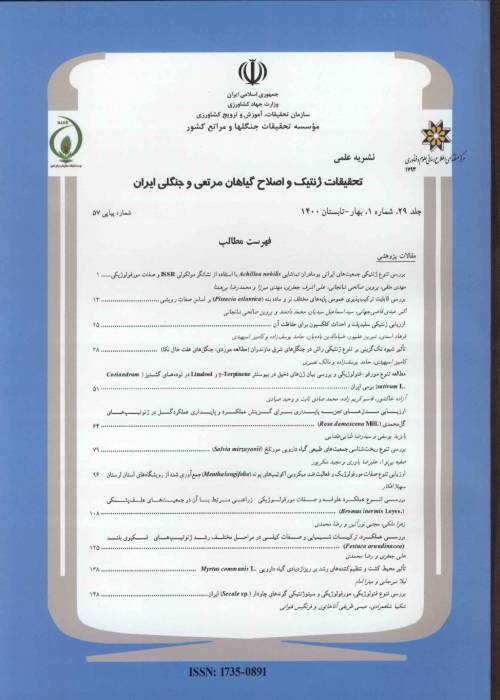Investigation of forage production in some cultivated and wild annual clovers using green water in semi-humid temperate regions of Iran
Author(s):
Article Type:
Research/Original Article (دارای رتبه معتبر)
Abstract:
Berseem clover (Trifolium alexandrinum), is one of the most important imported species of cultivated clover that cultivated for many years in the south and north of Iran. To increase the diversity of clover in agricultural systems, the genetic resources of annual wild clovers have been collected and evaluated over the past years in Iran. But, the reaction of these resources in semi-humid temperate regions of the north of Iran has not been investigated the forage production. For this purpose, 17 accessions of clover from eight species, including three cultivated species as: T. alexanderinum, T. resupinatum, and T. incarnatum; and five wild species of T. angostifolium, T. echinatum, T. diffusum, T. lappaceum, and T. purpureum along with the local cultivar of Berseem clover were cultivated and evaluated based on randomized complete block design with three replications, over two years (2018 and 2019) under rainfed conditions in Gorgan, Iran. The required moisture to the plant was provided by natural rainfall. After harvesting, the dry forage yield of each plot was calculated and the data of the two years were analyzed using nested ANOVA and mean comparisons were made using Duncan’s test. Results showed a significant difference among the species for forage yield. Forage dry matter yield ranged from 2063 kg/h in T. diffusum to 6120 kg in T. resupinatum, respectively. Based on coefficient of variation (CV) and fluctuation of forage production over two years, T. resupinutum and T. incarnatum had the highest and T. lappaceum and T. purpureum had the lowest forage production and CVs. This study showed that the genetic resources of Barseem clover available in the Iranian National Plant Gene Bank, as well as accessions of 50TN00250 (Persian clover), and 50TN00708 (T. echinatu) could be used as direct cultivation for forage production in the northern regions of Iran within the range of annual precipitation (212-425mm). But, the wild clovers 50TN00555 (T. purpureum), 50TN01238 (T. lappaceum), 50TN01548 (T. angostifolium), and 50TN01443 (T. diffusum) due to their low CV in different rainy conditions and their low yield, need further breeding researches for improve varieties in northern regions of Iran.
Keywords:
Language:
Persian
Published:
Iranian Journal of Rangelands Forests Plant Breeding and Genetic Research, Volume:30 Issue: 1, 2022
Pages:
133 to 144
magiran.com/p2508093
دانلود و مطالعه متن این مقاله با یکی از روشهای زیر امکان پذیر است:
اشتراک شخصی
با عضویت و پرداخت آنلاین حق اشتراک یکساله به مبلغ 1,390,000ريال میتوانید 70 عنوان مطلب دانلود کنید!
اشتراک سازمانی
به کتابخانه دانشگاه یا محل کار خود پیشنهاد کنید تا اشتراک سازمانی این پایگاه را برای دسترسی نامحدود همه کاربران به متن مطالب تهیه نمایند!
توجه!
- حق عضویت دریافتی صرف حمایت از نشریات عضو و نگهداری، تکمیل و توسعه مگیران میشود.
- پرداخت حق اشتراک و دانلود مقالات اجازه بازنشر آن در سایر رسانههای چاپی و دیجیتال را به کاربر نمیدهد.
In order to view content subscription is required
Personal subscription
Subscribe magiran.com for 70 € euros via PayPal and download 70 articles during a year.
Organization subscription
Please contact us to subscribe your university or library for unlimited access!




